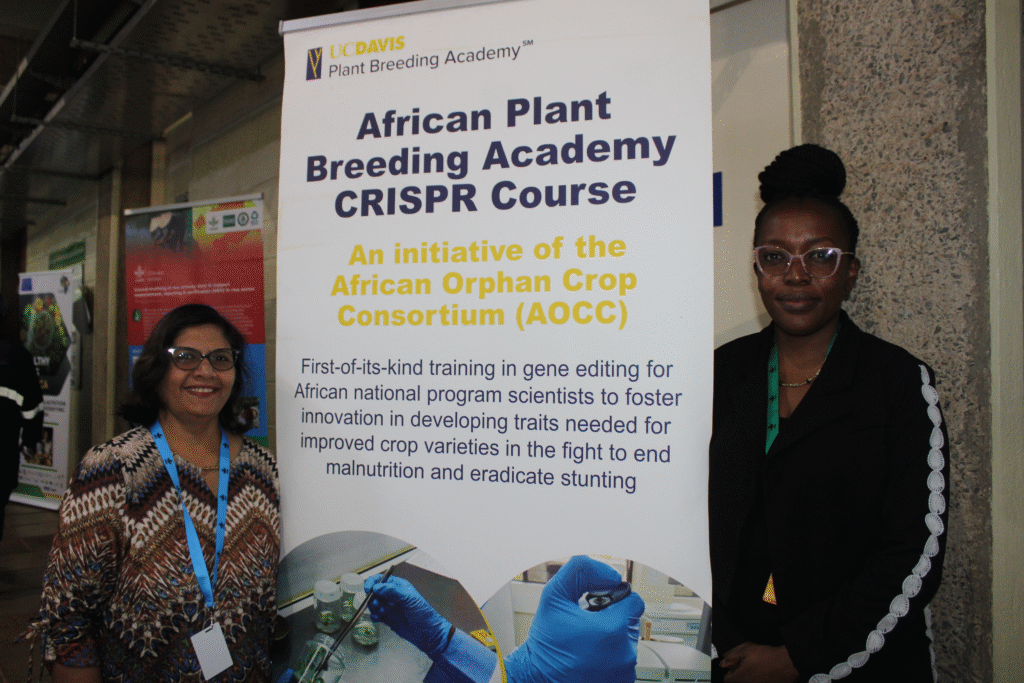Busani Bafana
The International Institute of Tropical Agriculture (IITA), a CGIAR center, places strong emphasis on growing the next generation of scientists in Africa, arming them with the tools to develop resilient, healthier and high-yielding crops to boost food security.
In the field of genome editing, it has been supporting PhD students, postdoctoral researchers, and early-career scientists under the African Plant Breeding Academy (AfPBA) Building on this strong foundation, IITA partnered with the University of California, Davis (UC Davis), Innovative Genomics Institute (IGI), UC Berkeley, California and other African Orphan Crops Consortium (AOCC) partners to implement CRISPR training programme for African scientists. The training programme aims to build a critical mass of skilled researchers who can harness transformative power of CRISPR — a gene editing technology — by turning science into solutions to revolutionise African agriculture.
The course provides participants with theoretical knowledge, hands-on laboratory experience, and exposure to regulatory frameworks. Since its launch in January 2023, 32 scientists from 10 African Countries (Kenya, Nigeria, Ghana, Ethiopia, Mozambique, Malawi, Morocco, Benin, South Africa and Burkina Faso) have been trained, acquiring the critical skills needed to integrate genome editing into national research programmes and establish local capacities.
Dr Leena Tripathi, IITA Director of the Eastern Africa Hub, Director of Genetic Innovation Science Area and Leader of the Biotechnology Programme, spoke about the African Plant Breeding Academy’s CRISPR course. Excerpts:
What is CRISPR technology and how does it work?
The CRISPR technology is based on a bacterial immune system. The reagents used in this technology are developed based on that system, and it is extremely precise and targeted. For example, if I want to manipulate a gene that causes disease in bananas, I can very precisely make it nonfunctional by creating a small incision in the gene, without introducing any foreign DNA.
The technology works like molecular scissors, making a precise cut in the DNA. Once the cut is made, no external input is needed as the organism uses its own natural repair machinery to fix the break.
The organism will not leave that DNA break unrepaired, it will repair and heal. During this repair process, some small mutations occur. These changes are very similar to spontaneous mutations which happen naturally. The only difference is that scientists can now do this in a highly targeted and controlled way. This precision and the absence of foreign gene integration make CRISPR a powerful tool for crop improvement and a more publicly acceptable alternative to traditional GMOs.
What gave rise to this CRISPR training?
To accelerate our breeding programme, IITA started using new breeding tools, like gene editing, specifically CRISPR- based editing technologies. We are using this tool to improve banana by developing disease-resistant varieties.
For example, we have developed varieties which are resistant to banana streak virus and bacterial wilt. In the case of bacterial wilt, we are disrupting the susceptibility gene. The susceptibility genes are responsible for disease symptoms, and we knock them out using gene editing. The beauty about this technology is that we don’t need to introduce any foreign gene, we just tweak the banana’s own DNA to build resistance using the gene editing.
We started working on CRISPR-Cas9- based genome editing in 2016 and became the first lab fully functional for doing genome editing in sub-Saharan Africa. However, no new technology is successful until you have a critical mass of trained people. That’s why capacity building is a cross-cutting goal across all our biotech projects.
Why is it important to develop scientific capacity for scientists and particularly, women?
This year, out of our cohort of eleven, six are female scientists. I personally believe that when you train a woman, you train an entire family.
Empowering women in science creates a ripple effect that benefits communities beyond the lab.
Lastly, can this CRISPR tool be applied across all crops?
Yes, it can be applied across all crops, livestock and even pharmaceuticals. I think it has applications everywhere. There are a few products in the market already. For example, Japan has approved GABA-enriched tomatoes, which help control blood pressure. There are also high oleic acid soybeans used for healthier oil and less pungent salad greens. Beyond agriculture, there are a lot of CRISPR applications in curing human diseases as well.
Where in Africa is this tool being used?
There are several countries in Africa which have developed the regulatory guidelines for gene editing, including Kenya, Nigeria, Ghana, Malawi, and recently Ethiopia. In Kenya, two gene-edited crops have been approved as non-GMO for field trials: a maize variety tolerant to maize lethal necrosis and a strigatolerant sorghum. Bacterial wiltresistant bananas are ready for field trials in Kenya.
How do you see this technology contributing to better and healthier food?
CRISPR technology has a lot of potential. It can help increase production by reducing losses from diseases and pests. As climate change impacts agriculture, this technology can also be used to develop climateresilient crops that tolerate abiotic stresses. Furthermore, it can improve the quality of the food by enhancing nutritional traits, for example, high oleic soybean oil or vitamin D-enhanced tomatoes, which are currently under development. There is also the development of semi-dwarf maize though it is not yet on the market. Our lab is also working on developing semi-dwarf yams. Yams are climbing plants that require staking, which increases labour demands, especially for women. By creating short-structured bushy-type yam varieties, we aim to reduce labour intensity, and make farming more efficient and inclusive.

